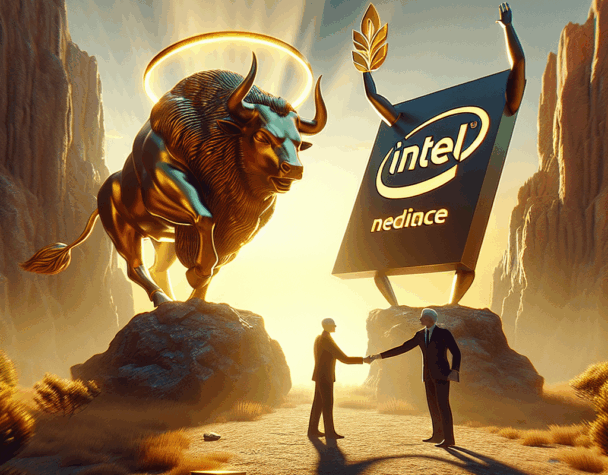
AMD Analyst Day Fuels Rally; Lawsuit & Intel Risk!
Thu, November 13, 2025Introduction
This past week put AMD squarely in the headlines. The company’s long-awaited analyst day and bullish forward guidance sparked a significant share-price rally, but two tangible headwinds — patent litigation from Adeia and a potential competitive threat from the Intel–Nvidia collaboration — introduced measurable risk. Below is a concise, fact-based rundown of the key events, the numbers investors should care about, and what to watch next.
What Happened This Week
Analyst Day: Big Targets and Product Roadmap
On November 11, AMD hosted its first analyst day in three years. Management laid out aggressive growth targets and a product timetable aimed at expanding the company’s presence in AI compute and data-center infrastructure. Highlights included:
- Projected average revenue growth above 35% over the next 3–5 years.
- AI data-center revenue growth guidance at roughly 80% annually.
- Roadmap mentions: MI400 accelerators arriving soon, a Helios rack system expected in 2026, and MI500-class chips targeted for 2027.
Those projections and the hardware roadmap gave investors renewed confidence that AMD is serious about expanding beyond CPUs and into full-stack AI systems.
Immediate Stock Reaction
The market responded quickly. Following the analyst day and related public remarks from CEO Lisa Su and CFO Jean Hu, AMD shares jumped sharply — with intraday moves of roughly 9–10% on November 12 and notable pre-market gains earlier that day. Heavy trading volumes underscored institutional interest as traders priced in the company’s aggressive AI ambitions.
Concrete Risks AMD Acknowledged
Intel–Nvidia Collaboration Called Out
In a rare explicit admission, AMD named the recently disclosed Intel–Nvidia partnership as a material competitive risk. AMD’s concern is practical: a combined Intel CPU platform and Nvidia GPU/SoC capabilities could create integrated systems that put pressure on AMD’s APUs and data-center offerings via bundled performance or pricing advantages. For investors, this isn’t hypothetical — it’s a strategic development AMD views as capable of affecting unit sales and margins.
Adeia Patent Lawsuits Target Key Tech
On November 3, Adeia filed two separate lawsuits in federal court alleging infringement of multiple patents tied to semiconductor manufacturing techniques. Several of the patents referenced are relevant to technologies AMD uses in high-performance designs (including 3D stacking concepts). Adeia is seeking damages and could pursue injunction relief. Litigation of this sort creates three clear investor concerns:
- Potential one-time financial liability if damages are awarded or settled.
- Risk of injunctions or licensing requirements that could alter product timelines or costs.
- Execution distraction and legal expenses that erode near-term margins.
Why These Events Matter to Investors
Taken together, the week’s developments present a classic growth-versus-risk trade-off. The upside is concrete: AMD’s roadmap and growth targets suggest rapid revenue expansion driven by AI data-center demand and new system-level offerings (racks and accelerators). The downside is equally tangible: new legal exposure and intensifying competition from large incumbents with complementary strengths.
Short-Term vs. Long-Term Considerations
- Short-term: Expect elevated volatility. News flow on litigation progress, any regulatory details about the Intel–Nvidia arrangement, and early customer traction for Helios or MI400 chips will likely move the stock.
- Long-term: Execution is everything. Hitting >35% CAGR and delivering double-digit share gains in AI accelerators requires manufacturing scale, design wins, and predictable supply — all doable, but not assured.
Practical Takeaways for Investors
- View the analyst-day numbers as a strong commitment, not a guarantee. Management set ambitious targets that should be validated by upcoming revenue beats and product launches.
- Monitor the Adeia lawsuits closely: settlement terms or court rulings could carry financial and operational implications.
- Watch competitive moves from Intel and Nvidia for integration plans or bundled offerings that could undercut AMD’s value proposition.
- Consider valuation discipline: the rally priced in substantial growth. Position sizing and stop-loss rules matter amid higher execution risk.
Conclusion
Last week was pivotal for AMD. The company’s analyst day re-energized investors by mapping a clear path into AI infrastructure, but that optimism is tempered by real legal and competitive threats. For disciplined investors, the right response is neither blind enthusiasm nor outright fear: it’s close tracking of execution milestones (product deliveries, design wins, revenue beats) and legal developments that could materially change fundamentals. Keep an eye on MI400 rollouts, Helios customer engagements, Adeia case updates, and any further disclosures about Intel–Nvidia cooperation — those items will define AMD’s trajectory in the months ahead.
If you’d like, I can convert these items into a monitoring checklist, a short watchlist of events and dates to track, or a risk-adjusted valuation model reflecting the new guidance and legal exposure.
